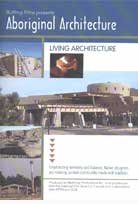
Aboriginal Architecture: Living Architecture 2005
Distributed by Bullfrog Films, PO Box 149, Oley, PA 19547; 800-543-FROG (3764)
Produced by Mushkeg Productions in cooperation with the National Film Board of Canada
Directed by Paul M. Rikard
DVD, color, 93 min.
Jr. High - Adult
Architecture, Native American Studies, Anthropology, Multicultural Studies
Date Entered: 10/12/2006
Reviewed by Sandy River, Architecture and Humanities Librarian, Texas Tech UniversityWhat kinds of buildings would North America's indigenous peoples build if they were allowed a hand in the design and building? It has only been in recent years that native professionals have had the opportunity to design for their communities. Aboriginal Architecture: Living Architecture shows us the kinds of buildings that have been produced for seven native North American communities: Pueblo, Inuit, Mohawk, Crow, Navaho, Coast Salish, and Haida. In each case the new buildings incorporate elements of the past -- traditional forms, designs, and materials.
Each community is explored in a separate segment of the film. Each segment opens with a look at the environment in which the community lives. A member of the community, often an architect or designer, provides insights into the cultural heritage and traditional buildings of the group. Then we are shown how the culture is reflected in the new buildings. Close-ups show structural and design features of both the old and new. We see the form of the Mohawk long house incorporated into a community center. The Inuit snow house (igloo) is seen in a church. Rug patterns and stylized corn ears decorate the outside of a Navaho senior center. The treatment of the Native American past is not sentimental or romanticized. Values such as the reverence for the land and the importance of community are discussed as they play out in the design of the buildings. The film is not a lesson in indigenous life or a how-to on building in a way that shows respect for the environment. It is, however, very effective in demonstrating how cultural traditions can be expressed in modern architecture.
The technical quality of the film is superb. The photography that introduces us to the environment in which each community lives gives us an immediate feel for the setting. Models and animations are used to make clear how structures that are now ruins once looked or how traditional structures were made. The individuals who provide the commentary on each native community are articulate and engaging. The audio quality is uniformly good despite the variety of settings in which the speakers appear. A one page user guide in PDF format provides discussion questions for each segment of the film.
This film would be a very useful addition to collections supporting coursework in Native American Studies or the architecture of indigenous peoples. It would also be suitable for younger audiences studying Native American cultures.